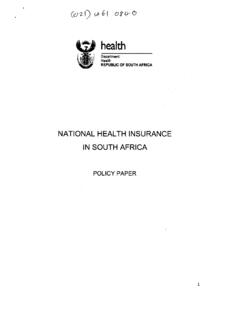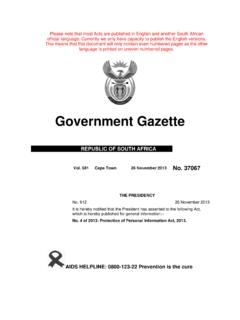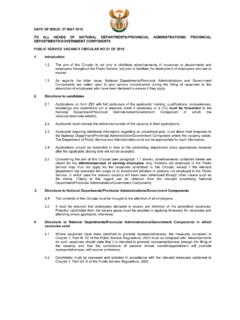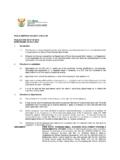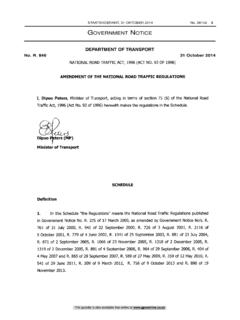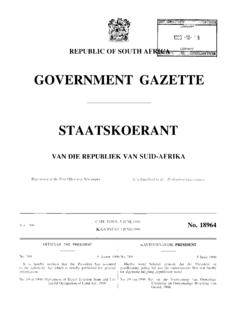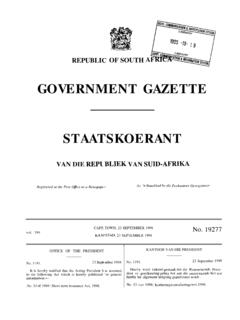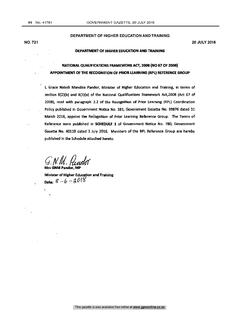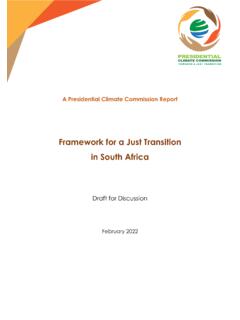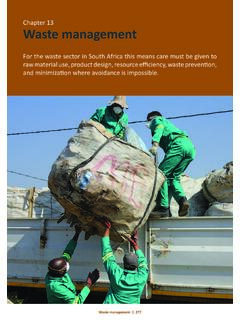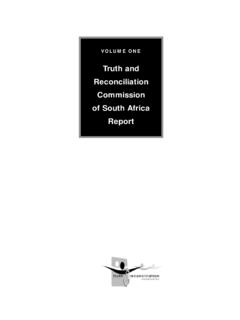Transcription of HUMAN RESOURCES FOR HEALTH SOUTH AFRICA - Gov
1 HUMAN RESOURCES FOR HEALTH . SOUTH AFRICA . HRH Strategy for the HEALTH Sector: 2012/13 2016/17. HRH SA. HUMAN RESOURCES for HEALTH SOUTH AFRICA HRH Strategy for the HEALTH Sector: 2012/13 2016/17. 11th October 2011. Acknowledgement The HRH Strategy for the HEALTH Sector: HUMAN RESOURCES for HEALTH SOUTH AFRICA Prepared with the funding from UK Department for International Development's programme for Strengthening SOUTH AFRICA 's Response to HIV and HEALTH , and management support from HLSP. Abridged version of the HRH SA Strategy for the launch of the HRH SA Strategy at University of the Witwatersrand, 11th October 2011. HRH STRATEGY FOR THE HEALTH SECTOR 2012/13 2016/17. 2. HRH SA. HRH Strategy for the HEALTH Sector: 2012/13 2016/17. Table of Contents 1 Overview of HRH Strategy for the HEALTH Sector: 2010/13 2016/17 ..10. 2 The Introduction ..13. The Epidemiological Strategic Implications of the Burden of Disease.
2 15. National Department of HEALTH Policy The New Policy of the Minister of HEALTH on Re-Engineering Primary HEALTH Care ..17. The Legislative Mandate ..18. The Economic 3 The Problem Statement: Trends and Challenges for HRH in SOUTH AFRICA ..20. Theme I: The Supply of HEALTH Professionals and Equity of Trend in public sector HRH numbers 1996 2010 .. 21. Historical expenditure on HEALTH personnel in the public 23. Current HEALTH professionals registered with the Councils .. 24. Current numbers by professional category in the public and private sectors .. 25. Access to HEALTH professionals in rural areas .. 30. Traditional 31. Migration of SOUTH African HEALTH 31. Attrition of Community Service professionals .. 33. Graduate unemployment and lack of absorption .. 33. Shortages and 34. International 35. Recruitment of foreign-trained HEALTH 36. Recommendations to inform Strategic Priorities.
3 38. Theme 2: Education, Training and Research ..40. Education and training of HEALTH professionals for the 40. Output of undergraduate HEALTH professionals from Higher Education 40. HRH STRATEGY FOR THE HEALTH SECTOR 2012/13 2016/17. 3. The training of specialist and subspecialist medical and dental 41. Output of nurses from nursing colleges and 42. The training of specialist 43. Public HEALTH specialists and public HEALTH professionals .. 44. The training of non-clinical professionals essential to the HEALTH sector .. 45. The employment of academic 45. The clinical training platform - Academic HEALTH Complexes (AHCs) and 46. Equity implications of the urban location of education and training sites .. 46. Research and innovation .. 47. The training of all professional categories .. 47. Training of Mid Level Workers (MLWs) .. 48. Training Community HEALTH 48. The training platform for professional education and training.
4 49. Planning the growth of HEALTH professionals .. 49. The cost of training HEALTH professionals .. 50. The financing of HEALTH professional 51. Quality of output of graduates and postgraduates from 52. The training of undergraduate medical students abroad .. 52. Information on graduate and postgraduate trainee 52. Stakeholder engagement in education and research development .. 52. Recommendations to inform Strategic Priorities .. 52. Theme 3: The Working Environment of the HEALTH Leadership and management .. 57. HUMAN Resource Management .. 58. Ensuring quality care .. 61. Information for planning .. 62. Workforce planning capacity and 62. Recommendations to inform Strategic 63. 4 Priority Workforce Implications for Re-Engineering Primary HEALTH Care ..65. The Model for Re-Engineering Primary HEALTH Care ..65. Priority Workforce Implications for Re-Engineering Primary HEALTH Care.
5 66. Task shifting and defining new roles .. 66. Community HEALTH Workers (CHWs).. 66. The Nursing Profession .. 67. District Clinical Specialists Teams (DCSTs) .. 67. Pharmacy assistants and other Mid-Level 68. Clinical 69. Environmental HEALTH Officers (EHOs).. 69. General Medical practitioners/Medical Officers .. 69. HRH STRATEGY FOR THE HEALTH SECTOR 2012/13 2016/17. 4. Emergency Care 70. Planning for service at all 70. Recommendations to Inform Strategic priorities .. 71. 5 HRH Strategy for the HEALTH Sector: 2012/13 2016/17 ..72. The HRH SA Strategy as a Guide to Action ..72. The Strategic Short, Medium and Long Term Strategic HRH Planning ..74. 6 Professions Forecast Modelling Assumptions ..127. Baselines used for modelling .. 127. Benchmarking .. 128. 130. Realistic 130. Model Outputs ..131. Model 131. Routine data from source .. 131. Recommendations ..131. Annexure A Data on HRH.
6 HRH STRATEGY FOR THE HEALTH SECTOR 2012/13 2016/17. 5. Table of Figures Figure 1: Proportions of leading categories of causes of death, 2010 Source: D Bradshaw, MRC 15. Figure 2: Total (public & private) HRH per 10,000 population per province, 2010 .. 26. Figure 3: Number of dental practitioners per 10,000 population in each sector, by province, 28. Figure 4: Number of medical practitioners per 10,000 population in each sector, by province, 2010 .. 29. Figure 5: Number of pharmacists per 10,000 population in each sector, by province, 29. Figure 6: Number of professional nurses actively working in the public and private sectors, by province, 30. Figure 7: Production of Registered Nurses 1996 - 2010 .. 42. Figure 8: Production of Enrolled Nurses 1996 - 2010 .. 43. Figure 9: NDoH: National organisational structures for planning and managing HRH .. 80. Figure 10: Factors influencing HEALTH professional workforce supply and demand.
7 86. Figure 11: University affiliation model (The SA Status Quo) .. 106. Figure 12: Consortium, network or joint partnership board model .. 107. Figure 13: Model for financing of academic medicine, the HEALTH Sciences and the Academic HEALTH 108. Figure 14: Scenario 3 resultant narrowing of identified gap'.. 133. List of Tables Table 1: HEALTH Professionals Employed in the Public Sector 1997 21. Table 2: Growth in public sector HEALTH professionals, 2002 22. Table 3: Percentage increase in selected public sector HEALTH professionals, absolute & per population, 2002-2010 .. 23. Table 4: Growth in public sector expenditure on the HEALTH workforce 2006/07 2010/11 (R million) .. 23. Table 5: OSD costs of public sector HEALTH professionals, 24. Table 6: HEALTH professionals per 10,000 for the public and private 27. Table 7: Distribution of SOUTH African HEALTH professionals abroad.
8 32. Table 8: Main push and pull factors in migration and international recruitment of HEALTH workers .. 32. Table 9: Retention Gap for HEALTH Professional Graduates 2002 2010 .. 33. Table 10: Specialist vacancies/opportunities in private sector hospitals, 2010 .. 34. Table 11: Comparative benchmarks for staffing per 10,000 population and HEALTH 35. Table 12: Potential policy interventions for the recruitment of foreign trained HEALTH professionals .. 37. Table 13: Number of MBChB Graduates, 2000 41. Table 14: Number of 'HPCSA Approved Registrar Training Posts' Vacant and Filled by Faculty .. 41. Table 15: Number of 'HPCSA Approved Sub specialist Training Posts' Vacant and Filled by 42. Table 16: Nursing Specialist Qualifications, 1996 2010 .. 44. Table 17: Expenditure - HEALTH Sciences Education and 51. Table 18: Summary of staffing benchmarks, ratios per 10,000 population.
9 129. Table 19: Scenario 3 Summary of gap for all HEALTH professionals, 2011-2025 .. 134. Table 20: Summary Plans for Major Categories .. 136. HRH STRATEGY FOR THE HEALTH SECTOR 2012/13 2016/17. 6. HRH SA. MINISTER'S STATEMENT OF POLICY AND COMMITMENT. Minister of HEALTH , Dr Aaron Motsoaledi We have a vision to improve access to HEALTH care for all and HEALTH outcomes in the short and medium term, with a particular focus on improving maternal and child HEALTH . To realise this vision we require the HUMAN RESOURCES to implement re-engineered Primary HEALTH Care and ensure the service capacity for a HEALTH system with improved financing through National HEALTH Insurance. It is necessary to develop and employ new professionals and cadres to meet policy and HEALTH needs, to increase workforce flexibility to achieve this objective, to improve the working lives of the existing workforce, to improve retention, increase productivity and revitalise aspects of education, training and research.
10 This HRH Strategy document is a guide to action. Starting with immediate effect we need to undertake a range of activities, make new policies, develop new programmes, make detailed staffing plans for new service strategies, and manage our HEALTH care workforce in ways that motivate them to provide quality HEALTH care. These activities need to be undertaken by provincial departments of HEALTH , faculties of HEALTH sciences, labour organisations, HEALTH care managers and professionals etc HRH SA strategies need to be developed in all these organisations using the national HRH Strategy as a guide. Realising our vision requires involvement of the many stakeholders in the HEALTH sector. We are committed to consultative engagement and to work together to build the HUMAN resource capacity and working environment to ensure quality HEALTH care. Most important HEALTH professionals and cadres must know that we value and need them.
